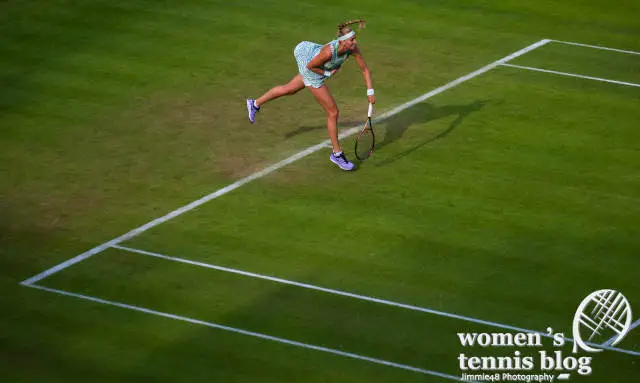While the grass-court season may be short, it presents an opportunity to witness how players adapt to this unique surface. If you ever find yourself with the chance to play or compete on grass, it’s crucial to understand the specific skills required to outmatch your opponents. Join tennis coach Marcin Bieniek as he delves into the art of mastering grass courts.

Grass-court tennis now and then
In the past, players were accustomed to battling it out on grass most of the time. Their game-styles were honed to perfection on these courts. However, the approach to the grass season has evolved significantly. Some players thrive in the fast-paced game and eagerly await the grass tournaments. On the other hand, some struggle to transition from more stable surfaces, stumbling and sliding as they try to change direction. And there are even those who choose to skip the grass season altogether, shifting their focus to the hard-court swing as soon as the clay season concludes.
When we look at the greatest players in tennis history, they have all excelled on grass courts. The Williams sisters, along with the formidable trio on the ATP side, are perfect examples of athletes who recognized the importance of adaptation. They trained relentlessly to acquire the necessary skills to thrive in a variety of environments. If you aspire to be a champion, don’t limit yourself to mastering a single surface. Developing a diverse set of skills equips you to handle any situation that arises during a match and gives you an edge over opponents who lack a backup plan when their initial strategies fall short on a given surface.
Essential skills for grass-court tennis
Playing on grass places pressure on movement and shot selection. Before stepping foot on the grass court, it’s crucial to focus on developing the skills necessary for success on this slippery surface.
Playing on the run
Playing on the run is a critical skill on a grass court, as the surface doesn’t allow for quick stops. Players must hit shots while in motion, requiring improved perception of distance while running and the ability to generate power without deceleration. Embracing a risk-taking mindset and looking for running winners becomes essential, as there is limited time to recover after responding to challenging shots. Mastering these skills will enable players to excel on the demanding grass surface, gaining an advantage over opponents who struggle with the unique movement patterns required.
Hitting slice shots and responding to slice shots
Slice shots are a formidable weapon on grass courts. A well-hit slice stays really low and it is not an easy job to respond to it effectively. To excel on this surface, players must work on two critical aspects: hitting slice shots in various areas of the court and effectively responding to slice shots with different directions, speeds, and trajectories. Additionally, incorporating the drop shot and mastering backspin adds further complexity to one’s game, presenting offensive players with significant challenges. By honing these skills, players can confidently navigate the changing rhythm of a rally and gain a competitive edge on the grass.
Solid flat and slice serve
The serve is unquestionably the most important shot in tennis, offering players the opportunity to practice it individually and utilize it in matches without the influence of their opponents. However, a quality serve must adapt to the characteristics of the playing surface, necessitating work on different types of serves to dominate rivals on all possible terrains.
On a grass court, flat and slice serves emerge as the most dangerous weapons. Players who can infuse their serves with solid power or skillfully slice them to keep the ball skidding away from their opponents prove exceptionally challenging to break. It doesn’t matter how good your serve is, because if the grass neutralizes all the strengths of your delivery, you won’t get any advantage, so refining both slice and flat serves becomes crucial. By practicing and perfecting these variations, you can consistently put your returner in difficult situations and gain a distinct advantage right from the start of every point.
Practice and be prepared
Being prepared for challenges is always superior to merely reacting to them. Playing on grass presents a significant challenge for many players, as the quick adjustment from clay or hard courts is far from easy. However, by understanding what to focus on in practice, you enhance your chances of being fully prepared for the unique intricacies that the grass game offers. This preparation also provides an opportunity to develop essential skills that enable you to maintain a high level of performance, even in the absence of extensive experience on grass courts.
To learn more from coach Marcin Bieniek, join his on-demand video training program and get a 30% discount with the code WTBPROMO. Also, visit our Tennis Tips page to learn how to ace your game on clay courts, pick the right toss for your serve, improve your backhand, hit stop volley, reduce net errors, respond to drop shots, change bad habits in your tennis, and much more.




